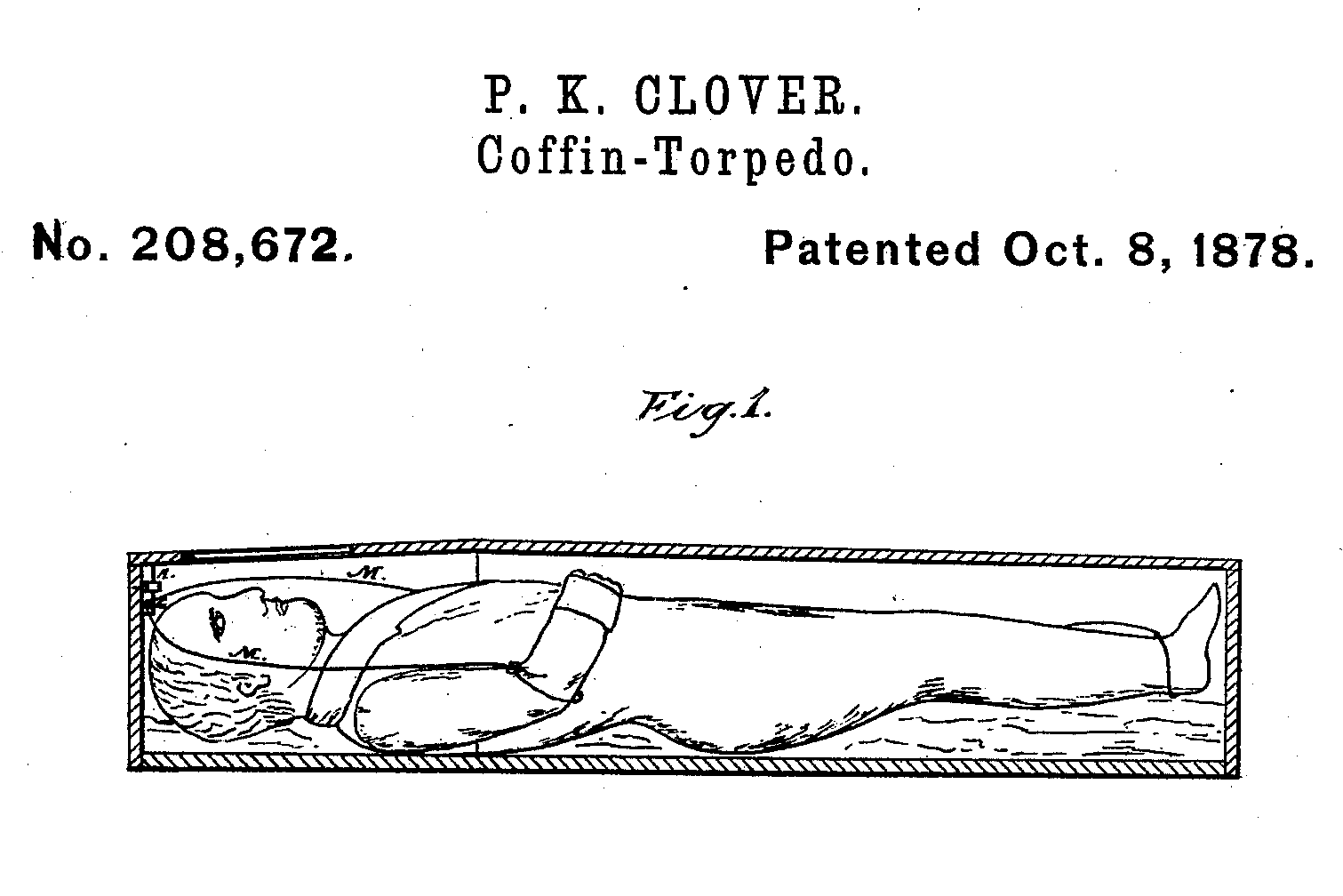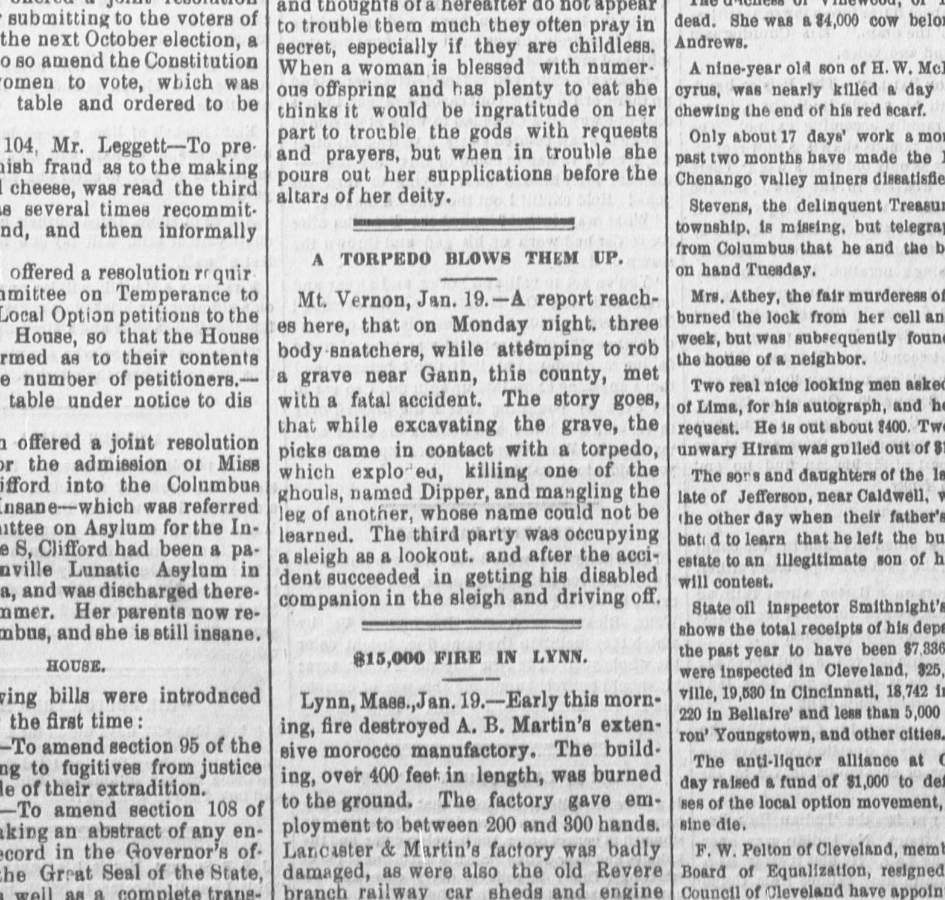Ohio's Ghoulish Gambit Against Grave Robbing: Coffin TorpedoesBy GABE ROSENBERG • 15 HOURS AGO
 Columbus inventor Philip K. Clover invented a device to kill grave robbers who tried to open coffins.
Columbus inventor Philip K. Clover invented a device to kill grave robbers who tried to open coffins.
UNITED STATES PATENT OFFICE John Scott Harrison, a former Ohio Congressman and the youngest son of U.S. president William Henry Harrison, died of heart problems in May 1878. To protect his rest, Harrison's family entombed him in a metal coffin surrounded by marble slabs, and hired an armed guard to stand watch.
It wasn't until days later did they realize Harrison's body was gone. Rather, it had been taken - to the Medical College of Ohio in Cincinnati.
The "Harrison Horror" wasn't the state's first notable grave-robbing, nor would it be the last. In fact, Ohio had a long and ghastly history of body snatching that lasted until the very end of the 19th century.
Harrison's abduction, though, sparked a nationwide outcry over the centuries-old practice and the institutions that condoned it.
If the government couldn't protect loved ones, people decided, then they had to find a way to do it themselves.
Supply And DemandHarrison's family wasn't even looking for him when they found his body.
Kevin Grace, an archivist at the University of Cincinnati, says when mourners arrived at Harrison's tomb, they saw a nearby grave had been disturbed.
"The next day they were searching for this other body they had thought had been stolen nearby Harrison’s grave, and the trail took them to the Ohio Medical School," Grace says.
A janitor at the school let them in, and Harrison's son noticed a rope hanging down in a shaft. He pulled it up, and at its end was Harrison.
"There's probably a payoff somewhere," Grace says.
But that a medical school had ended up with a stolen body was not, in fact, out of the ordinary. Medical schools in Ohio and around the globe were deep into the business of body-snatching.
That's for two reasons: Supply and demand.
...
"An angry mob ended up disbanding the college rather forcefully and running Morrow off to Cincinnati," Cutright says.
Ohio actually saw a number of riots against medical schools, says freelance writer Lucy Tiven, including in 1811, 1845, 1847, and 1852. But the grave robbing didn't stop.
An Explosive AnswerThe Harrison Horror, however, thrust grave-robbing back into the public eye. Because he was so famous, Grace says, the Congressman's abduction turned into national news.
“That incident is spread throughout the papers and really just instills a lot of fear in bourgeois and wealthy society that this can really happen to anyone," Tiven says.
Though Ohio passed an anatomy law the next year in response to the scandal, that didn't satisfy the still-growing demand from medical schools. As Tiven reports in a recent story for Atlas Obscura, two inventors in Central Ohio - Philip K. Clover in Columbus and Thomas N. Howell in Circleville - took their own swings at the problem.
Clover, an artist, and Howell, a former probate judge, individually filed patents in 1878 and 1881 for a "coffin torpedo."
 Philip K. Clover and Thomas Howell individually filed patents in 1878 and 1881 for a "coffin torpedo" that would protect bodies from grave robbers.
Philip K. Clover and Thomas Howell individually filed patents in 1878 and 1881 for a "coffin torpedo" that would protect bodies from grave robbers.
CREDIT UNITED STATES PATENT OFFICE“The basic idea is that when, you know, some sort of sly group of medical students or resurrection men contracted to steal a body start to steal a grave, there’s an explosive there that will detonate and basically just blast them to bits," Tiven says.
While Clover's invention worked like a shotgun, which would fire a blast of lead bullets if someone tried to open the coffin, Howell's operated more like a Civil War land mine.
“How to describe it, it would be a small almost like fishing line wire that would go across the chest, and either beside the head, neck or in the armpit, there would be a small barrel that would ignite when you ripped the body, or coffin open," Cutright says.
Ultimately, though, coffin torpedoes as a practice in the funeral industry never really blew up - so to speak.
“It was more that the idea that they were out there would prevent grave robbing," Cutright says.
One notable exception was a failed grave robbing incident in
Knox County, near Mount Vernon, where an explosion killed "one of the ghouls, named Dipper," and maimed another. The third member of their party survived and helped the injured man escape.
 An article in The Stark County Democrat from January 20, 1881, recounts an explosive killing one would-be grave robber and injuring another.
An article in The Stark County Democrat from January 20, 1881, recounts an explosive killing one would-be grave robber and injuring another.
CREDIT LIBRARY OF CONGRESSBut that was less a coffin torpedo, Tiven says, than just a booby-trapped coffin.
...
Realizing they needed to do something in order to stop grave robbing while preserving medical studies, Ohio physicians and legislators amended the state's anatomy law.
"That was really the end of body snatching then, by 1881, because bodies could be procured legally," Grace says, "and people could indicate they wanted to donate their bodies to science.”
No snatching required - and no need for the dead to fend off the living.
Excerpt. Read more at
http://radio.wosu.org/post/ohios-ghoulish-gambit-against-grave-robbing-coffin-torpedoes